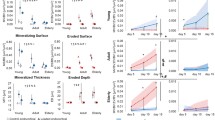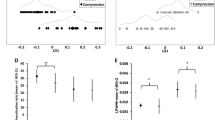Abstract
In order to analyze the effects on whole-bone behavior of aluminum accumulation, 14 rats, aged 90 days, received i.p. doses of 27 mg/day of elemental Al, as Al(OH)3, during 26 weeks, while 14 rats remained as controls. Their femur diaphyses were studied tomographically by peripheral quantitative computed tomography (pQCT) and mechanically tested in bending. The load/deformation curves obtained allowed distinction between effects observed during the linearly elastic (Hookean) and nonlinear (non-Hookean, or plastic) behaviors of bones before and after the yield point, respectively. Treatment reduced the cortical bone mineralization (volumetric bone mineral density [BMD], −2%; P < 0.01), with a negative impact on the bending stiffness (Young’s elastic modulus) and the yield stress of cortical bone (−18% and −13%; P < 0.05). Despite the absence of any cortical mass increase (cross-sectional area), improved spatial distribution of cortical tissue concerning anterior-posterior bending stress (cross-sectional moment of inertia, 10%; P < 0.05) occurred through a modulation of modeling drifts. Up to the yield point, neither the structural strength (load supported), the strain, nor the structural stiffness (load/deformation ratio) of the diaphyses were affected. This suggests an adaptive response of bone geometry to the impairment of bone material stiffness. However, Al intoxication significantly reduced the ultimate load and the post-yield fraction of that load (−6% and −27%; P < 0.05). This suggests that the proposed, adaptive response could have improved bone design so as to make it adequate for maintaining a normal pre-yield diaphyseal stiffness and strength according to the bone mechanostat theory, but not so as to provide complete protection of the diaphyseal post-yield (and ultimate) strength. Although a relative inhibition of bone formation could not be discarded, an Al-induced impairment of the bone ability to resist loads beyond the yield point could have caused the unusual disparity observed between effects on bone (elastic) stiffness and (ultimate) strength. In addition, to explain the unusual finding, these results suggest that little-studied microstructural factors (spatial arrangement of elements within the mineralized tissue) affecting the post-yield behavior of cortical bone, regardless of bone mineralization in these and other conditions, ought to be further investigated in specifically designed studies as a novel, promising resource in skeletal research.
Similar content being viewed by others
Author information
Authors and Affiliations
Corresponding author
About this article
Cite this article
Cointry, G., Capozza, R., Negri, A. et al. Biomechanical impact of aluminum accumulation on the pre- and post-yield behavior of rat cortical bone. J Bone Miner Metab 23, 15–23 (2005). https://doi.org/10.1007/s00774-004-0535-x
Received:
Accepted:
Issue Date:
DOI: https://doi.org/10.1007/s00774-004-0535-x




